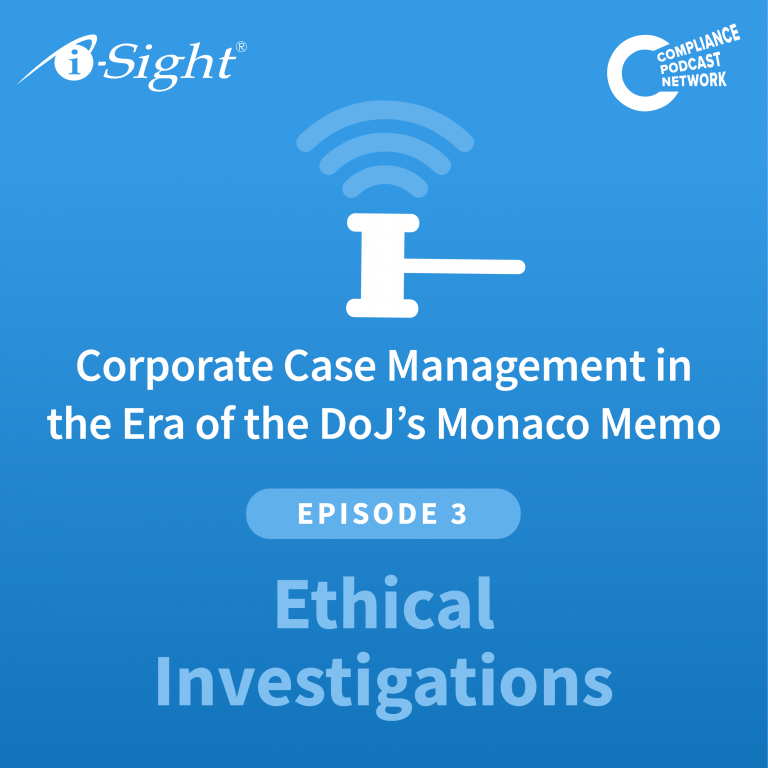Welcome to a special five-part blog series, entitled Corporate Case Management in the Era of the DoJ’s Monaco Memo, sponsored by i-Sight Software Solutions (i-Sight). Over this series, Jakub Ficner, Director of Partnership Development, and I consider how the Monaco Doctrine and Monaco Memo have impacted compliance in several key areas. We not only detail the changes wrought by the Monaco Memo but how compliance professionals can respond to these new challenges. In this Part 3, consider ethical investigations.
One of the key requirements which followed on from the Monaco Memo was the increased importance of internal corporate investigations. As important as internal investigations were in 2007 and 2012; they are even more important in 2022. Investigations need to be done quickly, efficiently, in a cost-effective manner and correctly. The quality in an investigation comes from identifying those who may be culpable, who may have participated or engaged in a legal violation. In terms of speed, the Department of Justice (DOJ) wants it yesterday. Ficner noted, “ultimately with the increased focus and corresponding with an increased investment into encouraging or speak up culture, there should multiple channels to submit complaints has led to the caseload per average investigator has increasing which has put additional strain on them.”
This leads to the need to help “make the lives of investigators easier, reduce the administrative burden placed on these investigators so that they can shift their time from manual repetitive tasks, filling in forms or paperwork, and focus it more on the value-add tasks of conducting the investigations. This is a key reason to lay out your protocol so your process can become repeatable in terms of the steps you want to follow and the timeframes within to follow them.” Many tasks can automatically be created based on the nature of the case and a number of other parameters to uniquely determine the steps needed to complete the investigation within delineated timeframes, having the reminders already factored so an investigator does not have to manually create an action plan.
With an automated case management system, an investigator can “consistently click a button and generate a report, provide a status report update, provide a summary report or even a final investigative report and then securely share those files from within the application.” Both tech and automation provide a key driver for implementing an advanced case management system. Ultimately, “where we see the biggest savings in terms of investigator’s time is reducing that administrative burden. Let’s take it out of their hands, let’s automate it. I’m adding consistency into my process and I’m enabling them to focus their time on better activities.”
Another important element is consistency, including transparency and maintaining an open process throughout the investigative steps. Ficner said, “consistency, is having a process in place, go through those steps and then consistently applying either our outcomes or disciplinary actions.” But it is also having a “consistent assessment process to be able to triage cases when they come in, being able to factor in things such as, do we have the right team or what team should work on it? Is there any conflict identified with that team?” This consistency can also come by having an automated case management program in place.
A key insight Ficner provided is “to have your decision makers ready, when it is time for a decision to be made.” Obviously, business executives have lots of things going on and based upon my work in the corporate world, legal and compliance is not always on their top of mind. This means an automated tool and case management system can help “keep the decision makers who may be outside the legal department or compliance department provided with the information they need to read or review or assess on a timely basis and in an efficient manner.”
Ficner provided the example of a legal department from a large multinational who had a challenge that their executives were “not looped in until way too late in their opinion. The executives were essentially given timeline for a decision, but they had no idea this matter was coming down the pipe until it hit their desk.” With an automated case management system, it can proactively trigger automated notifications to let executives know that this case has been reported. So, if the “expectation is within 60 days, the investigation would be complete and ready for executive review and approval. You can keep the automated notifications going out as you transition through the various steps of your investigation. And then when it hits the review and approval stage, it’s not a surprise.” This also allows for the report and attachments to be “packaged together neatly for them to just take that automated email that they receive, click it, have all the information structured in an easy to consume fashion so that they can make the right determination based on the information that the organization has developed in the investigation.”
Join us tomorrow where look at outcomes and the Fair Process Doctrine.



